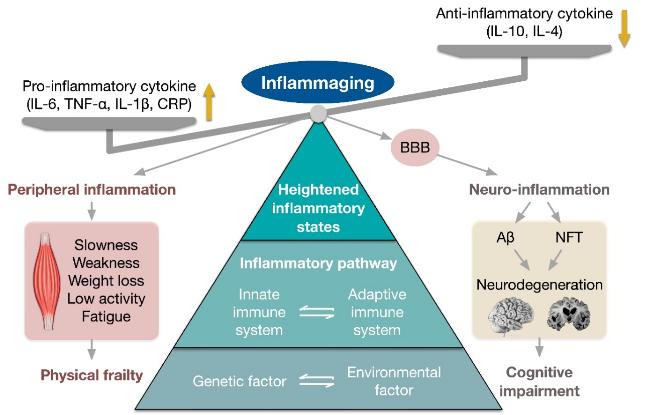Correlations between human alveolar macrophage particulate matter load, air pollution particulate matter levels, and systemic inflammation markers in Mexico City – Nature

Executive Summary
A study conducted in Mexico City investigated the associations between ambient particulate matter (PM) exposure, PM accumulation in human alveolar macrophages (AM), and systemic biomarkers of inflammation and oxidative stress. This research directly addresses key targets within the Sustainable Development Goals (SDGs), particularly SDG 3 (Good Health and Well-being) and SDG 11 (Sustainable Cities and Communities). The findings indicate that chronic exposure to urban PM2.5 contributes to its accumulation in lung immune cells, which is significantly associated with elevated levels of biomarkers for systemic inflammation and cardiovascular risk. These results underscore the urgent need for enhanced air quality management in urban environments to protect public health and advance the 2030 Agenda for Sustainable Development.
Introduction: Air Pollution and Sustainable Development Goals
Air pollution, particularly from particulate matter (PM), is a major global health threat that impedes progress towards several SDGs. This report details a study that provides critical biological evidence supporting the links between urban air quality and human health, with direct relevance to the following goals:
- SDG 3: Good Health and Well-being: Specifically Target 3.9, which aims to substantially reduce the number of deaths and illnesses from hazardous chemicals and air, water, and soil pollution and contamination.
- SDG 11: Sustainable Cities and Communities: Specifically Target 11.6, which calls for reducing the adverse per capita environmental impact of cities, including by paying special attention to air quality.
The study was conducted in the Mexico City Metropolitan Area (MCMA), a megacity where high levels of air pollution pose a significant challenge to creating a healthy and sustainable urban environment.
Methodology
Study Design and Population
The observational study involved 53 healthy, non-smoking adult residents from the Iztapalapa and Iztacalco municipalities of Mexico City. Biological samples, including bronchoalveolar lavage fluid (BALF), plasma, and urine, were collected to analyze cellular and systemic health markers.
Exposure Assessment and SDG 11
To assess ambient air pollution exposure, the study utilized an advanced Land Use Regression (LUR) model. This approach aligns with the objectives of SDG 11.6 by providing high-resolution spatial and temporal data on air quality, which is essential for effective urban environmental management.
- Data Integration: The LUR model was enhanced by incorporating PM2.5 monitoring data from official compliance stations and supplementary measurements taken at the homes of 21 study participants.
- Improved Accuracy: This methodology significantly improved the model’s performance (R2 = 0.81), allowing for a more precise estimation of individual PM2.5 exposure levels over various timeframes (1 day to 6 months).
Cellular and Systemic Biomarker Analysis
The study employed novel techniques to link environmental exposure to biological responses, providing insight into the mechanisms behind pollution-induced illness as targeted by SDG 3.9.
- PM Load in Alveolar Macrophages (AM): The fraction of AM containing PM (%AMPM) and the area of PM within these cells were quantified using automated cell image analysis software (CellProfiler). This serves as a direct biomarker of chronic PM inhalation and retention in the lungs.
- Systemic Biomarkers: Concentrations of key biomarkers were analyzed in BALF, plasma, and urine to measure inflammation, endothelial dysfunction, and oxidative stress. These included von Willebrand Factor (vWF), C-reactive protein (CRP), lactase dehydrogenase (LDH), and malondialdehyde (MDA).
Key Findings and Implications for Health (SDG 3)
Particulate Matter Accumulation in Alveolar Macrophages
A significant presence of PM was found in the lung immune cells of participants, with a median of 62.4% of AM containing PM inclusions. This cellular-level evidence demonstrates that residents of MCMA are internalizing harmful pollutants from their environment, highlighting a direct pathway for pollution to impact human health.
Association with Ambient PM2.5 Exposure
A clear dose-response relationship was identified between long-term air pollution and cellular PM load, particularly in individuals with lower initial accumulation. For participants in the lowest tertile of PM load, a 10 µg/m3 increment in the six-month average PM2.5 concentration was associated with an 8% increase in %AMPM. This finding suggests that chronic, even low-level, exposure contributes to a cumulative burden of pollutants in the lungs.
Systemic Health Impacts
The study established a statistically significant link between the PM load in lung cells and biomarkers of systemic disease, directly addressing the challenge of non-communicable diseases (SDG Target 3.4).
- Inflammation and Endothelial Dysfunction: The %AMPM showed a significant positive association with plasma von Willebrand Factor (vWF) (p = 0.016), a marker of endothelial damage and inflammation-related thrombosis.
- Cellular Damage: A significant positive association was also found between %AMPM and serum lactase dehydrogenase (LDH) (p = 0.026), an indicator of tissue damage and cardiovascular stress.
These findings suggest that the accumulation of urban PM in alveolar macrophages may trigger systemic inflammation and oxidative stress, increasing the risk for cardiovascular and other non-communicable diseases in otherwise healthy urban residents.
Conclusion and Recommendations for Sustainable Development
This study provides compelling evidence that exposure to ambient urban PM in Mexico City leads to the accumulation of pollutants in lung macrophages, which in turn is associated with systemic inflammation and an elevated risk of cardiovascular disease. The results reinforce the critical importance of addressing air pollution as a public health priority to achieve SDG 3 and SDG 11.
The findings strongly support the adoption of stricter air quality standards, such as the World Health Organization (WHO) guideline for an annual ambient PM2.5 concentration of 5 µg/m3. Achieving this target is essential for protecting the health of urban populations and building sustainable, resilient, and healthy cities for all.
1. Which SDGs are addressed or connected to the issues highlighted in the article?
The article primarily addresses issues related to two Sustainable Development Goals:
-
SDG 3: Good Health and Well-being
This goal is central to the article, which investigates the adverse health effects of air pollution. The study explores how exposure to ambient particulate matter (PM) in Mexico City leads to PM accumulation in lung cells (alveolar macrophages) and triggers systemic inflammation and oxidative stress. The abstract explicitly states that these findings “may trigger systemic inflammation and oxidative stress in healthy young residents,” directly linking environmental factors to human health outcomes. The introduction further emphasizes this by noting that PM exposure “represents a substantial global public health concern because of its numerous adverse health effects, including respiratory, cardiovascular, nervous system, and cancer morbidity and mortality.”
-
SDG 11: Sustainable Cities and Communities
The research is set within the Mexico City Metropolitan Area (MCMA), described as “one of the biggest megacities” that “experiences high levels of air pollution.” The study’s focus on urban air pollution and its impact on the health of city residents directly connects to the goal of making cities inclusive, safe, resilient, and sustainable. By assessing PM exposure levels using a Land Use Regression (LUR) model for an urban population, the article highlights the environmental challenges faced by large cities and the need for better air quality management to protect public health.
2. What specific targets under those SDGs can be identified based on the article’s content?
Based on the article’s content, the following specific SDG targets can be identified:
-
Target 3.4: Reduce by one-third premature mortality from non-communicable diseases (NCDs)
The article connects PM exposure to increased risk factors for cardiovascular disease, a major NCD. The study found that the PM load in alveolar macrophages (%AMPM) had a “statistically significant, positive association with plasma von Willebrand Factor (vWF) … and serum lactase dehydrogenase (LDH).” The discussion section explicitly states that vWF is a “predictor of adverse cardiac events” and LDH is a “known marker of cardiovascular disease.” By identifying and measuring these biological markers, the study provides evidence for the mechanisms through which air pollution contributes to the burden of NCDs, which is a key concern of Target 3.4.
-
Target 3.9: Substantially reduce the number of deaths and illnesses from hazardous chemicals and air, water and soil pollution and contamination
This target is directly addressed by the entire study. The research aims to understand the illnesses caused by air pollution. The abstract concludes that “ambient urban PM exposure in Mexico City contributes to PM accumulation in AMs and may trigger systemic inflammation and oxidative stress.” This directly investigates the link between air pollution (a form of contamination) and illness (inflammation, oxidative stress, and increased cardiovascular risk), aligning perfectly with the objective of Target 3.9.
-
Target 11.6: Reduce the adverse per capita environmental impact of cities, including by paying special attention to air quality
The article’s methodology and context are directly related to this target. The study is conducted in Mexico City, a megacity with significant air pollution challenges. A core component of the research is the estimation of “ambient PM2.5 concentrations” using an improved Land Use Regression (LUR) model. By focusing on measuring and modeling urban air quality (specifically PM2.5) and linking it to health outcomes, the article underscores the importance of monitoring and reducing the adverse environmental impact of cities, as stipulated in Target 11.6.
3. Are there any indicators mentioned or implied in the article that can be used to measure progress towards the identified targets?
Yes, the article mentions and implies several indicators that can be used to measure progress towards the identified targets.
-
Indicator for Target 11.6 (Indicator 11.6.2: Annual mean levels of fine particulate matter (e.g. PM2.5) in cities)
The article directly uses this indicator. It develops and applies a Land Use Regression (LUR) model specifically to “approximate PM exposure levels” and estimate “ambient PM2.5 concentrations (µg/m3)” for residents in Mexico City. The study measured daily PM2.5 concentrations that “were between 6.3 and 86.5 µg/m3” and used six-month averaged concentrations to find associations with health effects. This measurement of PM2.5 levels is the exact indicator used to track progress on urban air quality under Target 11.6.
-
Indicators for Target 3.9 (related to Indicator 3.9.1: Mortality rate attributed to household and ambient air pollution)
While the article does not measure mortality rates, it provides crucial morbidity indicators that are precursors to mortality and illness from air pollution. These can be seen as complementary measures:
- PM load in alveolar macrophages (%AMPM): The study proposes and measures the “fraction of AM containing PM (%AMPM)” as a direct biological indicator of chronic PM exposure and its cellular impact. The article states it “serves as a highly representative and specific biomarker of particulate exposure.”
- Biomarkers of systemic inflammation and oxidative stress: The study measures concentrations of specific molecules in blood, urine, and lung fluid that indicate illness caused by pollution. These include “plasma von Willebrand Factor (vWF),” “serum lactase dehydrogenase (LDH),” “C reactive protein (CRP),” and “Malondialdehyde (MDA).” These serve as measurable indicators of the physiological damage and illness resulting from air pollution exposure.
-
Indicators for Target 3.4 (related to reducing premature mortality from NCDs)
The article implies the use of risk factor indicators for NCDs. The positive correlation found between PM load (%AMPM) and biomarkers like vWF and LDH serves as an indicator of increased cardiovascular risk. The article notes that “Plasma vWF is a predictor of adverse cardiac events” and “LDH is known marker of cardiovascular disease.” Therefore, the levels of these biomarkers in a population exposed to air pollution can be used as an indicator to measure the environmental contribution to NCD risk.
4. Create a table with three columns titled ‘SDGs, Targets and Indicators” to present the findings from analyzing the article.
| SDGs | Targets | Indicators |
|---|---|---|
| SDG 3: Good Health and Well-being | Target 3.4: Reduce premature mortality from non-communicable diseases (NCDs). |
|
| SDG 3: Good Health and Well-being | Target 3.9: Substantially reduce deaths and illnesses from air pollution. |
|
| SDG 11: Sustainable Cities and Communities | Target 11.6: Reduce the adverse per capita environmental impact of cities, paying special attention to air quality. |
|
Source: nature.com

What is Your Reaction?
 Like
0
Like
0
 Dislike
0
Dislike
0
 Love
0
Love
0
 Funny
0
Funny
0
 Angry
0
Angry
0
 Sad
0
Sad
0
 Wow
0
Wow
0

















































:focal(1500,1000)/https://media.globalcitizen.org/a6/9a/a69a4720-d8a1-4715-b596-18738d03c05c/rotary_polio_hero_image.jpg?#)






/countries/sri-lanka/photo-credit---dmc-sri-lanka.tmb-1200v.jpg?sfvrsn=dc298bcc_1#)
















